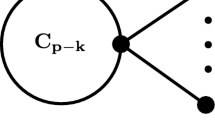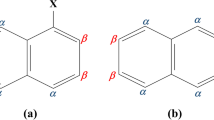Abstract
Hierarchical enumerations of octahedral derivatives are conducted in accord with the hierarchy of groups for characterizing an octahedral skeleton, i.e., point groups (\({\varvec{O}}\) and \({\varvec{O}}_{h}\); orders 24 and 48) \(\subset \) RS-stereoisomeric group (\({\varvec{O}}_{h\widetilde{\sigma }\widehat{I}}\); order 96) \(\subset \) stereoisomeric group (\(\widetilde{{\varvec{O}}}_{h\widetilde{\sigma }\widehat{I}} \,(= {\varvec{S}}^{[6]}_{\sigma \widehat{I}})\); order 1440) \(=\) isoskeletal group (\(\widetilde{\widetilde{{\varvec{O}}}}_{h\widetilde{\sigma }\widehat{I}} \,(= {\varvec{S}}^{[6]}_{\sigma \widehat{I}})\); order 1440). The corresponding cycle indices with chirality fittingness (CI-CFs) are calculated by using combined-permutation representations (Fujita in MATCH Commun Math Comput Chem 76:379–400, 2016). Then, a set of three ligand-inventory functions for 3D enumeration is introduced into the CI-CFs for the enumerations under the point groups and the RS-stereoisomeric group, while a single ligand-inventory function for 2D (graph) enumeration is introduced into the CI-CFs for the enumerations under the stereoisomeric group and the isoskeletal group. The expansion of the resulting equations gives generating functions, in which the coefficients of respective terms show the numbers of octahedral derivatives. They are discussed by drawing isomer-classification diagrams after they are categorized into octahedral derivatives with achiral proligands, those with achiral and chiral proligands, and those with chiral proligands. Type-I and type-V stereoisograms are drawn to demonstrate the conceptual distinction between RS-stereogenicity and stereogenicity, where the combination of configuration indices and C/A-descriptors is discussed.










Similar content being viewed by others
Notes
The symbols \([\theta ]_{15}^{*}\), \([\theta ]_{19}^{*}\), \([\theta ]_{27}^{*}\), \([\theta ]_{30}^{*}\), \([\theta ]_{40}^{*}\), and \([\theta ]_{45}^{*}\) in Table 2 should be corrected to be \([\theta ]_{15}\), \([\theta ]_{19}\), \([\theta ]_{27}\), \([\theta ]_{30}\), \([\theta ]_{40}\), and \([\theta ]_{45}\).
References
A. Werner, Beitrag zur Konstitution anorganischer Verbindungen. Z. Anorg. Chem. 3, 267–330 (1893)
E.C. Constable, C.E. Housecroft, Coordination chemistry: the scientific legacy of Alfred Werner. Chem. Soc. Rev. 42, 1429–1439 (2013)
E.C. Constable, Stereogenic metal centers—from Werner to supramolecular chemistry. Chem. Soc. Rev. 42, 1637–1651 (2013)
N.P.E. Barry, P.J. Sadler, 100 years of metal coordination chemistry: from Alfred Werner to anticancer metallodrugs. Pure Appl. Chem. 86, 1897–1910 (2014)
A. von Zelewsky, Stereochemistry of coordination compounds. From Alfred Werner to the 21st century. Chimia 68, 297–298 (2014)
A. Werner, Über die raumisomeren Kobaltverbindungen. Justus Liebigs Ann. Chem. 386, 1–272 (1912)
A. Werner, Zur Kenntniss des asymmetrischen Kobaltatoms. I. Ber. Dtsch. Chem. Ges. 44, 1887–1898 (1911)
G. Pólya, Kombinatorische Anzahlbestimmungen für Gruppen, Graphen und chemische Verbindungen. Acta Math. 68, 145–254 (1937)
G. Pólya, R.C. Read, Combinatorial Enumeration of Groups, Graphs, and Chemical Compounds (Springer, New York, 1987)
B.A. Kennedy, D.A. McQuarrie, C.H.B. Jr, Group theory and isomerism. Inorg. Chem. 3, 265–268 (1964)
R.F. Timble, Isomers of octahedral complexes with nonbranching ligands. J. Chem. Educ. 31, 176–179 (1954)
M. Brorson, T. Damhus, C.E. Schäffer, Exhaustive examination of chiral configurations of edges on a regular octahedron: analysis of the possibilities of assigning chirality descriptors within a generalized \(\delta /\lambda \) system. Inorg. Chem. 22, 1569–1573 (1983)
S. Fujita, Symmetry and Combinatorial Enumeration in Chemistry (Springer, Berlin, 1991)
S. Fujita, Promolecules with a subsymmetry of \( {O}_{h}\). Combinatorial enumeration and stereochemical properties. Polyhedron 12, 95–110 (1993)
S. Fujita, N. Matsubara, Edge configurations on a regular octahedron. Their exhaustive enumeration and examination with respect to edge numbers and point-group symmetries. Internet Electron. J. Mol. Des. 2, 224–241 (2003)
S. Fujita, Mathematical Stereochemistry (De Gruyter, Berlin, 2015)
S. Fujita, Stereoisograms of octahedral complexes. I. Chirality and RS-stereogenicity. MATCH Commun. Math. Comput. Chem. 71, 511–536 (2014)
S. Fujita, Stereoisograms of octahedral complexes. II. RS-Stereogenicity versus stereogenicity as well as RS-stereoisomerism versus stereoisomerism. MATCH Commun. Math. Comput. Chem. 71, 537–574 (2014)
S. Fujita, Stereoisograms of octahedral complexes. III. Prochirality, pro-RS-stereogenicity, and pro-ortho-stereogenicity free from the conventional prochirality and prostereogenicity. MATCH Commun. Math. Comput. Chem. 71, 575–608 (2014)
S. Fujita, Combinatorial Enumeration of Graphs, Three-Dimensional Structures, and Chemical Compounds (University of Kragujevac, Faculty of Science, Kragujevac, 2013)
S. Fujita, Type-itemized enumeration of RS-stereoisomers of octahedral complexes. Iran. J. Math. Chem 7, 113–153 (2016)
S. Fujita, Diagrammatical Approach to Molecular Symmetry and Enumeration of Stereoisomers (University of Kragujevac, Faculty of Science, Kragujevac, 2007)
S. Fujita, Computer-oriented representations of point groups and cycle indices with chirality fittingness (CI-CFs) calculated by the GAP system. Enumeration of three-dimensional structures of ligancy 4 by Fujita’s proligand method. MATCH Commun. Math. Comput. Chem. 76, 379–400 (2016)
S. Fujita, Computer-oriented representations of \( {O}_{h}\)-skeletons for supporting combinatorial enumeration by Fujita’s proligand method. GAP calculation of cycle indices with chirality fittingness (CI-CFs). MATCH Commun. Math. Comput. Chem. 77, 409–442 (2017)
S. Fujita, Graphs to chemical structures 1. Sphericity indices of cycles for stereochemical extension of Pólya’s theorem. Theor. Chem. Acc. 113, 73–79 (2005)
S. Fujita, Graphs to chemical structures 2. Extended sphericity indices of cycles for stereochemical extension of Pólya’s coronas. Theor. Chem. Acc. 113, 80–86 (2005)
S. Fujita, Graphs to chemical structures 3. General theorems with the use of different sets of sphericity indices for combinatorial enumeration of nonrigid stereoisomers. Theor. Chem. Acc. 115, 37–53 (2006)
S. Fujita, Promolecules for characterizing stereochemical relationships in non-rigid molecules. Tetrahedron 47, 31–46 (1991)
S. Fujita, Importance of the proligand-promolecule model in stereochemistry. I. The unit-subduced-cycle-index (USCI) approach to geometric features of prismane derivatives. J. Math. Chem. 50, 2202–2222 (2012)
S. Fujita, Importance of the proligand-promolecule model in stereochemistry. II. The stereoisogram approach to stereoisomeric features of prismane derivatives. J. Math. Chem. 50, 2168–2201 (2012)
S. Fujita, Misleading classification of isomers and stereoisomers in organic chemistry. Bull. Chem. Soc. Jpn. 87, 1367–1378 (2014)
S. Fujita, Classification of stereoisomers. Flowcharts without and with the intermediate concept of RS-stereoisomers for mediating between enantiomers and stereoisomers. Tetrahedron: Asymmetry 27, 43–62 (2016)
S. Fujita, Chirality and RS-stereogenicity as two kinds of handedness. Their Aufheben by Fujita’s stereoisogram approach for giving new insights into classification of isomers. Bull. Chem. Soc. Jpn. 89, 987–1017 (2016)
S. Fujita, Stereogenicity revisited. Proposal of holantimers for comprehending the relationship between stereogenicity and chirality. J. Org. Chem. 69, 3158–3165 (2004)
S. Fujita, Pseudoasymmetry, stereogenicity, and the RS-nomenclature comprehended by the concepts of holantimers and stereoisograms. Tetrahedron 60, 11629–11638 (2004)
S. Fujita, Three aspects of an absolute configuration on the basis of the stereoisogram approach and revised terminology on related stereochemical concepts. J. Math. Chem. 52, 1514–1534 (2014)
K. Mislow, J. Siegel, Stereoisomerism and local chirality. J. Am. Chem. Soc. 106, 3319–3328 (1984)
A. von Zelewsky, Stereochemistry of Coordination Compounds (Wiley, Chichester, 1996)
R.S. Cahn, C.K. Ingold, V. Prelog, Specification of molecular chirality. Angew. Chem. Int. Ed. Eng. 5, 385–415 (1966)
V. Prelog, G. Helmchen, Basic principles of the CIP-system and proposal for a revision. Angew. Chem. Int. Ed. Eng. 21, 567–583 (1982)
S. Fujita, Stereoisograms for reorganizing the theoretical foundations of stereochemistry and stereoisomerism: II. Rational avoidance of misleading standpoints for R/S-stereodescriptors of the Cahn-Ingold-Prelog system. Tetrahedron: Asymmetry 25, 1169–1189 (2014)
S. Fujita, The stereoisogram approach for remedying discontents of stereochemical terminology. Tetrahedron: Asymmetry 25, 1612–1623 (2014)
N.G. Connelly, T. Damhus, R.M. Hartshorn, A.T. Hutton, Nomenclature of Inorganic Chemistry. IUPAC Recommendations 2005 (The Royal Society of Chemistry, Cambridge, 2005)
Author information
Authors and Affiliations
Corresponding author
Rights and permissions
About this article
Cite this article
Fujita, S. Hierarchical enumeration of octahedral complexes by using combined-permutation representations. J Math Chem 56, 2845–2875 (2018). https://doi.org/10.1007/s10910-018-0921-6
Received:
Accepted:
Published:
Issue Date:
DOI: https://doi.org/10.1007/s10910-018-0921-6




